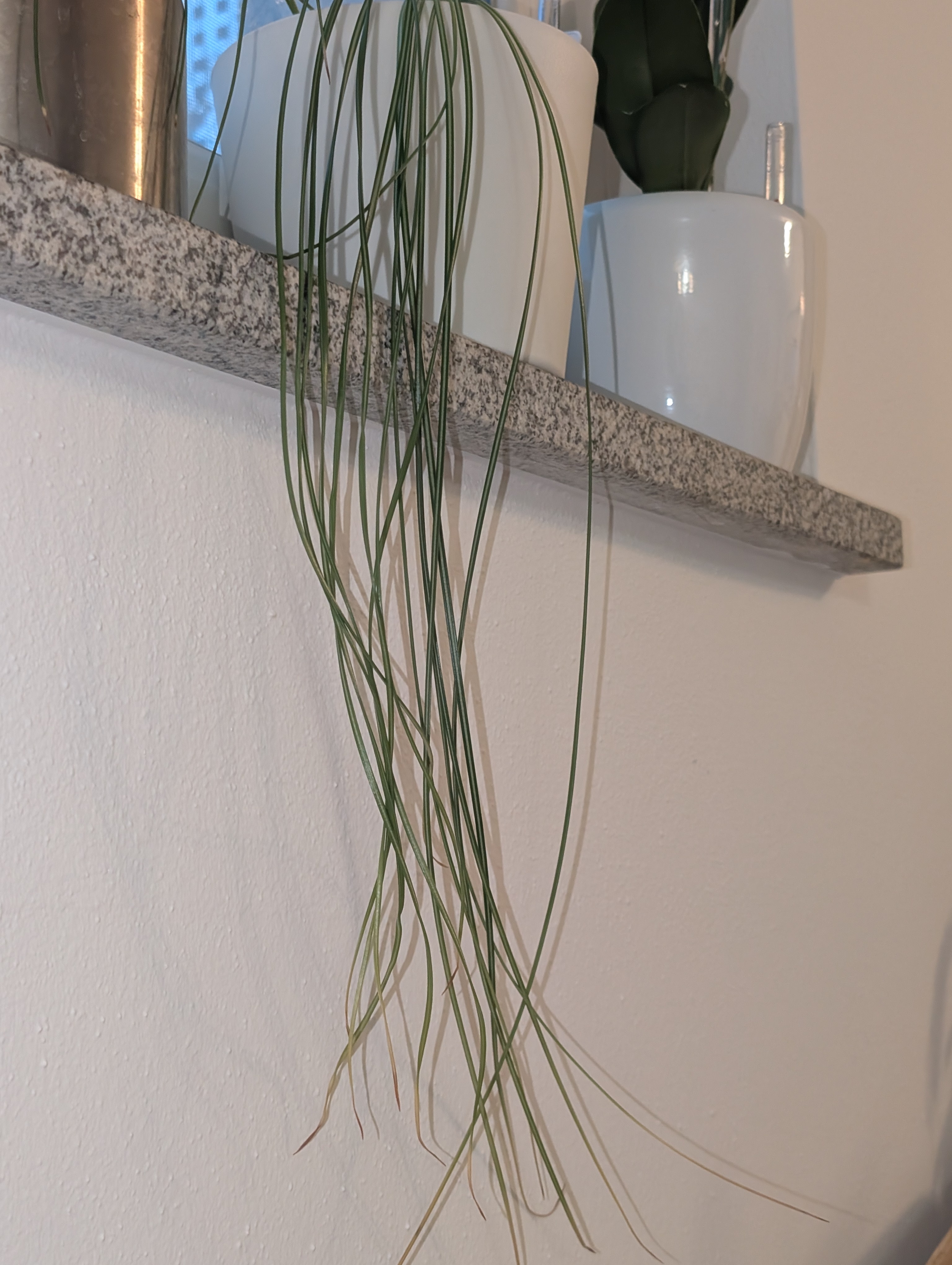Günther Unlustig 🍄
Peter Lustig’s unlustiger verschollener Sohn mit weirden Interessen und Gadsen.
🇩🇪 DE/EN 🇬🇧
<Explaination for anyone not knowing obscure German media>
Peter Lustig used to be the moderator in an old German kids science and nature series called “Löwenzahn” (Dandelion) who shaped our generation.
He also shaped my childhood, and I want to honour him.
My real name also isn’t “Günther”, it’s just a reference to “Olaf, Olaf, Olaf, Günther” from Spongebob: The Movie, because I wanted it to sound like a real name and it makes conversations easier.
- 32 Posts
- 46 Comments

 3·24 hours ago
3·24 hours agoFeel free to also join !gruenerdaumen@feddit.org if you want to see German content or !hydroponics@slrpnk.net for hydro stuff :)
I can answer you pretty much any question you asked in detail, but I have to keep it more brief, because answering everything extrensively would take hours. Just ask if you are interested in something and want to know more.
pure coco is a bit like dry hydroponics
There is no dry hydroponics. Hydro doesn’t mean something has to sit in water, just that it doesn’t eat decaying matter (soil).
Is this kind of substrate to be treated as organic or as mineral approach? The compost probably adds the typical soil properties including the buffering of pH and EC and taking care of fertilization.
The other ingredients in there besides compost mostly add structure and prevent waterlogging.
Mentioning EC in soil doesn’t make much sense, and dissolved salts don’t get buffered much afaik, how should they?
Once the compost is depleted, can I consider it to be like a non-soil grow?
Nope, just organic, but now with depleted soil :D
You can add organic fertilizer, which is basically “ultra compact compost” if you see it like that.I wouldn’t add mineral fertiliser into organic soil, because it will heavily disrupt the soil life.
I got a pH/EC sensor to check my water and the drain coming out
Soil ≠ Hydro. Measuring something in soil doesn’t work that easily than in hydro, and you can’t change that stuff anyway, at least not that fast and easily.
I’ve had pH values of 8 in soil and still the plants looked fine. I believe the mycorrhizal networks can change nutrient uptake.
The pH in soil is often controlled by the microorganisms living there.diluted a pH- down based on diluted citric acid to normalize my water to 6,5pH, which seems like a good starting point for any situation.
Citric acid will break down by bacteria, and then the pH will be way higher than what you’ve started with, at least in my experience.
I recommend you to buy proper pH down, usually based on Phosphoric acid.
Also, definitely use pure water, e.g. rain, distilled or reverse osmosis.
Tap water has a lot of minerals in it, which add a lot of “crap” to your nutrient solution, which will cause the nutrient lockout you mentioned you had with your tomatoes.I tried anything (boiling, diluting, whatever) and always came back to pure water, because I always had problems with tap water (Germany, like you).
pH swings and deficiencies, even at proper pH, are pretty much guaranteed, at least from what I’ve heard and experienced. If you have a crap load of calcium, acids in there, they will complete with the nutrients.
Does it make sense to follow some generic approach (like keeping pH/EC in certain ranges in certain growth stages)?
Half the recommended strength (or just pure RO water) for seedlings, normal strength for everything else that’s leafy (houseplants, growth phase of veggies, etc.) and 1,5-2x strength for flowering or fruiting plants.
I personally run ~ 1,0 mS for most stuff, and 1,5 mS for flowering.
Measure the EC regularly, and if it lowers, add more fertilizer next time.Depends on your humidity/ evaporation and light intensity.
I do not want to use commercial fertilization formula schemes. I want to work with standard off the shelf mineral fertilizers. Is it possible to get decent results with that?
I use Masterblend for everything and like it a lot. Weed, houseplants (orchids, calathea, etc.), you name it. They all thrive.
It’s cheap and works well. Maybe I’ll change my mind someday, but at least for now, I can recommend it.
I made a life hack post on how I dose it if you’re interested.
My advice for you in general is to invest in proper hydro stuff and not to find workarounds for everything. I tried that and failed miserably.

 2·1 day ago
2·1 day agoI wouldn’t bother with seeds tbh. Starting seeds is playing genetic lottery, and you might end up having weak plants.
I’d use wild occuring ones if I were you. The whole selection game has already been played there for you.
You can also create a “bandage” and keep it wet. That will cause roots to form there

 3·2 days ago
3·2 days agoI can’t speak for huckleberries, but what I’d do maybe is to take a locally growing strong huckleberry and take a cutting off it. The plant doesn’t have to be pretty, heavy fruit bearing, or whatever, just the most vigorous one.
Grow it to a small trunk, and then graft a heavy fruit bearing cultivar on it. By doing that, you’ll get the best out of two worlds: a locally native and strong root stock, and highest quality fruit.
Regarding seed starting, I already made a post about it. Here it is

 6·4 days ago
6·4 days agoDid you let the cutting dry before? If not, you may risk rotting

 4·11 days ago
4·11 days agoUsually yes, but not in my case.
I only fertilize my hydroponic stuff, where everything is in pots and in a very very resource efficient closed loop system.
I personally would never use mineral fertilizer for soil, not even my potted plants.

 3·15 days ago
3·15 days agoHydroponically, I’m growing weed, bell chilis, pepino, cantaloupe and some leavy greens. So, perennial produce in general.
Yeah, of course, feel free to ask and share anything you’d like. Doesn’t matter if you grow on coco coir, aero, DWC or whatever, everyone is welcome here!
I would advise against it. 150 ml sounds very small, and it is also transparent.
The only idea I would have is to use a wicking style setup, where the plant pot is standing on the lid, and the container acts as a reservoir.

 3·2 months ago
3·2 months agoYou can check out !balconygardening@slrpnk.net.
I’m doing !hydroponics@slrpnk.net, but I also have quite a few pots of soil (dirt) there.
They are mainly there for co-plants that attract beneficial insects and help to improve the biodiversity of this concrete hell I live in.
This “intact” ecosystem with healthy organic living soil, beneficial plants and other stuff also has the benefit that it attracts predatory insects like ladybugs, which naturally kill any lice and other harmful pests without any pesticides.
Oh, and it looks nice, and I always can gift other people I like some flowers if the need arises, for example as a last-minute birthday present ;)
I will also create an insect protection community here on SLRPNK if you’re interested :)

 7·3 months ago
7·3 months ago+1 for uBlue (Aurora, Bazzite).
Everything you want and need is already set up for you, and the OS is just in the background for your games and other software to run on. No need to install any codecs, or even updating it, because it’s already done for you. And if something breaks, then you can just roll back in seconds.
Very user friendly.

 1·3 months ago
1·3 months agoi am not into gardening much, but your photos look great. You seem to have a good microscope, maybe you can buy some stains (not very expensive unless you buy good stuff to quantise) and even do some charecterisation.
Thanks! 💚 Most of the pictures were just shot in macro mode on my phone, I’m a bit ashamed to admit it 😄
But I do have a microscope too, and the pics of the springtails were shot with it.What stains do you recommend?
I believe I have Methylene blue lying around somewhere, maybe that might be useful for a living-dead-characterization?But to be honest, I didn’t think much about looking up the stuff under the microscope, because I was pretty sure it was mold. I think you can even see the hyphae on the colony on the picture.
From what I got, you have a mildly basic master batch, which you dilute.
My fertiliser is a two-part solution. I mix them with demineralised water, and the final diluted solution has a pH of 6,2-ish, without pH adjuster. But I didn’t test it with the part A solution, which is the one that got moldy. It is probably moderately acidic.
[…] Adding Peroxide/ other oxidizers
Not a big fan of that idea. On the first glance it makes sense, but my arguments against that are:
- I highly doubt that the fertilizer is resistant against bleach. There are quite a few chelated minerals in it, and I’m sure that they will get destroyed or at least precipitate out of solution. And
- Even though mycorrhizae (and bacteria) are not remotely as important in hydroponics as they are in soil, I still highly value a healthy ecosystem of healthy microbes, that keep the bad guys at bay. If I add a oxidizing agent to the nutrient solution, it will kill a lot, mainly the good guys. And then bad things, like root rot, happen.
I’m now trying to mitigate that problem by pressure cooking small batches (a bunch of 200 ml bottles instead of 1 liter) and keeping them sealed until use, which will only last a week or so until used up.
My bigger question is, is this growth really problematic or not
It is. In hydroponics, everything should be as clean as possible. Not sterile-clean, but at least not full of slime or dirty.
If there is (too much) organic contamination, it will attract pests. And those specs are organic matter, and I already got the spring tail infestation from it, as I already mentioned in the post.Regarding worms: I also have a few pots with organic soil (no-till, cover crops, etc.) outside, with a very healthy ecosystem, and an absolute shit ton of earth worms. If they would be a tiny bit bad for plant health, I would consider them as infestation :D I’m glad they aren’t.
After a rain fall and temperature drop in early winter, there were literally hundreds, if not thousands, crawling around on my super small balcony, just from the three pots or so!
Again, I am a gardening noob, and not a chemist, so what I may have said may as well be shit, please feel free to correct me.
Please! You sound both like a chemist AND someone with gardening experience. You seem to already have quite a lot of knowledge, keep going on! 😊

 11·3 months ago
11·3 months agoThe thing is, that we live in a microbe filled world. Even if I sterilize everything, like in a pressure cooker, it will result in just another contamination if I open up the bottle next time.

 3·3 months ago
3·3 months agoThe instance I’m on is down from time to time, and it has been yesterday too sadly. Now it’s back and everything should load properly :)

 1·3 months ago
1·3 months agoYeah, that’s what I was also thinking. We live in a microbe filled world, and even if the content in the bottle is sterilized, opening it up once will result in another contamination.

 4·3 months ago
4·3 months agoI will try that.
I also thought about it. But I’m not sure if it works, because I think many chemicals in there might be temperature sensitive and then reacting somehow.

 3·3 months ago
3·3 months agoThing is:
- How should I handle it otherwise, especially for small amounts, like my 1 l watering can?
- How do other manufacturers sell liquid fertilizer, and those don’t go bad either?

 3·3 months ago
3·3 months agoI don’t wanna use that (or other desinfecting/ oxidizing agents) in the final nutrient solution, because that would damage the ecosystem of beneficial microbes and then the bad guys would take over.
And in the fertiliser concentrate, this would probably oxidize quite a few complexes and minerals, resulting in the fertiliser going bad.



While organic vs. “hydro” is more of a spectrum and in some cases hard to define, I’d say it’s better to clearly separate them to get the most benefits out of each concept.
That sums it up very well.
When growing organically, you can let the microbes (and small critters) do the work for you. You don’t know what they do, but they just do stuff, and you don’t or can’t worry about it.
It’s more of a layed back thing.
Weeds now don’t exist anymore, they’re now just called “cover crops”, and pests don’t demolish your crops, they’re just waiting to get eaten by other beneficial insects 😁
Maybe read my guide on passive hydro with LECA. It has similar benefits, but is completely inorganic and my substrate of choice.
Fertilizers are mostly the same. They all use the same ingredients in one form or another.
You can easily switch from T.A. to Plagron to Masterblend for example, that shouldn’t be much of a problem.
You still need to get a bit of experience, but I find it way easier to diagnose problems and trends.
While the two disciplines seem to be separated from each other, you can still greatly benefit from mastering both.
For me, hydro mostly just means soil-less.
You are correct. The effects of synthetic fertiliser on soil is sometimes a bit exaggerated. Microbes are kind of tolerant to minerals, it’s just that you steal their jobs and weaken the connection between them and the plant. Read more about mycorrhizal networks if you’re interested in that topic :)